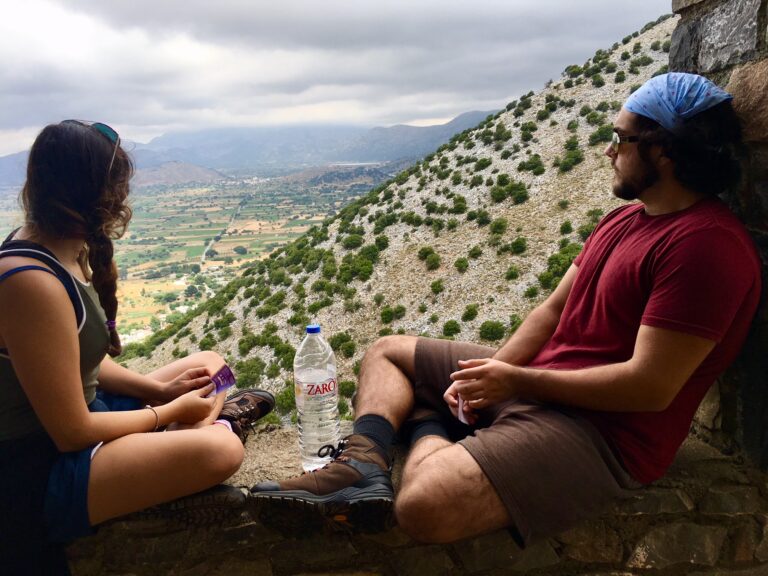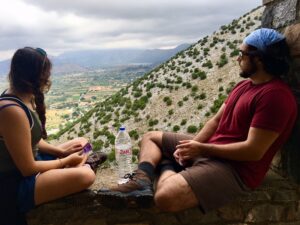As October draws to a close, we here in America (and many countries besides) prepare to celebrate Halloween. Our bowls of candy are full in anticipation of hordes of costumed youth, with our houses decked in artificial cobwebs and plastic bats, orange and purple neon lights blinking in and out of focus. We go to parties or stock up on toilet paper for a night that revolves more around tricks instead of treats. Horror movies play on an almost constant rotation, and scary stories told by a fire are extra special this time of year.
Greece, however, does not have a Halloween. For them, October 31st is just another fall day, and life continues on as per usual without a ghoul or gremlin in sight. But that doesn’t negate the fact that Greek mythology and folklore are practically rife with ghoulies from the get-go. From hundred-headed hydras to fire-breathing dragons, from the vengeful cyclops to the terrifying gorgon, the Greeks are no strangers to things that go ‘bump’ in the night. So on this special Halloween edition of our blog, let’s take a look at some of my favorite Greek monsters. ‘Tis the season, after all.
Vrykolakas
The Vampire has had a stranglehold on mainstream consciousness for an eternity, even before Bram Stoker debuted his epistolary novel Dracula in 1897. Since then, of course, Count Dracula has been portrayed in over 200 films alone, and the ‘vampire genre’ is certainly alive and kicking, even if their main characters aren’t. But before the rules of the vampire were established through this vast literary and film canon, there were earlier myths and legends from all across the globe of blood-sucking beasts who stalked the night. Though eastern Europe may be able to lay the strongest claim when it comes to the most easily recognizable vampiric myth, the ancient Greeks had one such creature lurking on the periphery of their folklore.

The vrykolakas is, in many ways, closer to a ghoul or zombie rather than our traditional understanding of the vampire. Instead of drinking the blood of its’ victims, the vrykolakas had a penchant for human livers, though most other bits of flesh would do in a pinch. Like their vampiric cousins, the vrykolakas were once perfectly normal human beings, but due to living a sacrilegious life, being buried in unconsecrated ground, or simply having the fatal combination of having red hair with grey eyes, they would rise from their graves to stalk the living. Terrorizing their former villages, the bloated, ‘drum-like’ vrykolakas brought with it plague, death, and fear. Some myths even describe the creature crushing their victims by sitting on their chests to suffocate them. Their appearance in the villages would often be heralded by knocking at front doors and calling out the names of old friends and family. To this day, many Greek villages hold a superstition that you shouldn’t answer the door until you hear the second knock, lest you be murdered and subsequently turned into a vrykolakas yourself. Of course, you can pre-emptively prevent your family or friends from turning into a vrykolakas by burying them in consecrated ground, but if you’re too late and you need to take care of business, you must impale, behead, cut up, or cremate the body on a Saturday, (when the vrykolakas must rest).
There have been several archaeological finds to suggest that ancient peoples feared the vrykolakas enough to do something about them. Tombs from Cyprus, Khirokitia, Attica and Lesbos all have graves that contained bodies that had been ‘pinned’ down with spikes in their extremities to prevent the interred from rising from their respective graves. Some bodies were cut in half, or had portions of their limbs removed. But the legend of the vrykolakas isn’t as far removed from the modern day as you might think. During World War 2, Greece experienced a massive widespread famine that resulted in over 300,000 people starving to death. The resulting influx of bodies led to cemeteries reaching capacity, and the government decided to implement the use of mass graves in unconsecrated ground. This led to many distraught family members to preemptively behead the bodies in order to prevent their deceased loved ones from coming back from the dead.
So watch out for your next knock at the door. For all you know, it could be your last.
Werewolves
The Greek myths, though not the first to mention the concept, contain some of the earliest werewolf stories in our global consciousness. The legend centers around an Arcadian king named Lycaon and his fifty sons, and the resulting tragedy of what happens when you try to test the gods. Lycaon has a complicated history, as many mythological figures do, and there are a million myths that portray the king and his fifty sons in different lights, significantly altering the myth. However, the most common myth goes a little something like this:

After Lycaon had founded the kingdom of Arcadia and his sons, in turn, founded various cities that to this day still bear their names, the family fell into a state of debauchery and ‘nefariousness,’ disregarding social rules that Zeus himself had established long ago. In order to test the family, Zeus appeared to them as a hungry peasant, begging for food and shelter. Lycaon and his family opened their doors to him, but in a perversion of the laws regarding hospitality, proceeded to butcher the youngest of Lycaon’s sons, (or grandson, or even a complete stranger, depending on the myth you read), and used his meat for the meal. The reasoning for this act of cruelty? Perhaps it was to test the belief that any stranger could be Zeus in disguise, and wanted to deliberately disrespect him. Perhaps it was a baseless act of cruelty for cruelty’s sake. Whatever the reason, Lycaon had angered Zeus, who was horrified by such a blatant disregard for hospitality, one of the tenets that was so sacred to him. In response, he transformed Lycaon and all his children into wolves, and brought the murdered son back to life. According to Ovid, this transgression is what brought about the great flood from the myth of Deucalion.
Lycaon’s impact on the werewolf myth is nothing short of foundational. It is also said the king founded the festival Lycaea, a celebration for the god Zeus, during which a man chosen by lottery was forced to perform a human sacrifice, and upon doing so, took on the physical form of a wolf. For nine years this man wandered the wilderness in his new shape, only returning home and regaining humanity in the tenth year. This festival, which also included athletic games, continued into the 2nd Century A.D., but whether or not the participants were truly werewolves is…highly disputed, to say the least. Even the name for those cursed to become a werewolf, lycanthropy, comes from the titular Lycaon. Though the story may not be the most familiar to fans of this particular monster, you can’t ignore Lycaon’s influence on modern-day werewolf lore.
The Minotaur
Of the various monsters, ghouls and creatures found within Greek Mythology, I have a special place in my heart reserved for the Minotaur. After all, he’s practically a mascot for the island of Crete, and you can’t wander into a single store without seeing some reference to him, his sister Ariadne, or the heroic Theseus in some way, shape or form.
When Minos, king of Crete, chose not to sacrifice a prized bull to Poseidon, the gods bewitched his wife Queen Pasiphaë to fall madly in lust with the bull. Her sacrilegious union brought about a child with the body of a man and the head of a bull, and as he grew nothing could sate his hunger but the taste of human flesh. Humiliated, but unable to kill the child, Minos locked him away in a labyrinth under his palace at Knossos, engineered by the great inventor Daedalus. When Crete conquered the kingdom of Athens, Minos demanded a sacrifice of 14 virgins, 7 men and 7 women, to be sacrificed to the creature that lived within the bowels of his palace. This practice carried on for many years before the hero Theseus took the place of one of the sacrifices, and with the help of the Cretan Princess Ariadne and her magic ball of golden thread, found his way to the center of the labyrinth and slew the creature, liberating his people. Of course, there are many more intricacies of the myth to parse and chew over, but the thought of being trapped in a dark, mildewy labyrinth while a hungry creature chases me down to eat my flesh is just as frightening as any jump scare Hollywood can dream up. And the best part about the myth? It’s possible to visit the labyrinth today!

Knossos is an archaeological site just outside of downtown Heraklion on the island of Crete, and only 20 minutes away from Villa Bella Mare of Wine Dark Sea Villas. First excavated by Minos Kalokairinos in 1877, the excavations were taken over in 1900 by English archaeologist Arthur Evans, whose controversial assumptions and reconstructive work have resulted in disputes as to their accuracy. However, it remains an important and ongoing archaeological site that contributed much to our understanding of Minoan culture that you can visit to this day! Though one can dispute the existence of the Minotaur itself, it’s a thrilling site to explore should you happen to find yourself on the island of Crete on Halloween. Who knows? Maybe you’ll find traces of a monster lurking around the corner, waiting to devour you.
With so many monsters in Greek mythology, it was difficult to pick just three to focus on today. I could write a book on the witches, ghosts, goblins and monsters that are alive and well in folklore and legend, but I think I’ll leave those for a later date. Or better yet, for you to discover your favorites for yourselves. In the meantime, carve a pumpkin, feast on chocolate, and tell some spooky stories by the fire.
Maybe even one of these.
By Katarina Kapetanakis













